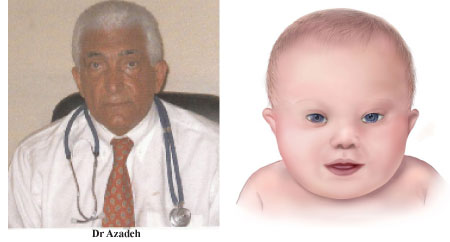
In every cell in the human body there is a nucleus, where genetic material is stored in genes. Genes carry the codes responsible for all of our inherited traits and are grouped along rod-like structures called chromosomes.
Typically, the nucleus of each cell contains 23 pairs of chromosomes, half of which are inherited from each parent. Down syndrome occurs when an individual has a full or partial extra copy of chromosome 21.
This additional genetic material alters the course of development and causes the characteristics associated with Down syndrome. A few of the common physical traits of Down syndrome are low muscle tone, small stature, an upward slant to the eyes, and a single deep crease across the centre of the palm - although each person with Down syndrome is a unique individual and may possess these characteristics to different degrees, or not at all.
Dr Azadeh, our health adviser, a senior lecturer at the University of The Gambia and senior consultant in Obstetrics & Gynaecology is this week focusing on “pregnancy and health” and continuing with the issue of Down Syndrome (also few cases in the Gambia recorded) and explains about prevention, causes, diagnose and dignities facilities in the Gambia.
How Common Is Down Syndrome?
One in every 691 babies in the the United States is born with Down syndrome, making Down syndrome the most common genetic condition. Approximately 400,000 Americans have Down syndrome and about 6,000 babies with Down syndrome are born in the United States each year. So far no statistics in the Gambia.
When Was Down Syndrome Discovered?
For centuries, people with Down syndrome have been alluded to in art, literature and science. It wasn’t until the late nineteenth century, however, that John Langdon Down, an English physician, published an accurate description of a person with Down syndrome.
What Causes Down Syndrome?
Regardless of the type of Down syndrome a person may have, all people with Down syndrome have an extra, critical portion of chromosome 21 present in all or some of their cells. This additional genetic material alters the course of development and causes the characteristics associated with Down syndrome.
The cause of no disjunction is currently unknown, but research has shown that it increases in frequency as a woman ages. However, due to higher birth rates in younger women, 80% of children with Down syndrome are born to women under 35 years of age.
There is no definitive scientific research that indicates that Down syndrome is caused by environmental factors or the parents’ activities before or during pregnancy.
The additional partial or full copy of the 21st chromosome which causes Down syndrome can originate from either the father or the mother. Approximately 5% of the cases have been traced to the father.
Down syndrome occurs in people of all races and economic levels, though older women have an increased chance of having a child with Down syndrome. A 35 year old woman has about a one in 350 chance of conceiving a child with Down syndrome, and this chance increases gradually to 1 in 100 by age 40. At age 45 the incidence becomes approximately 1 in 30. The age of the mother does not seem to be linked to the risk of translocation.
Since many couples are postponing parenting until later in life, the incidence of Down syndrome conceptions is expected to increase. Therefore, genetic counseling for parents is becoming increasingly important. Still, many physicians are not fully informed about advising their patients about the incidences of Down syndrome, advancements in diagnosis, and the protocols for care and treatment of babies born with Down syndrome.
Does Down Syndrome Run in Families?
All 3 types of Down syndrome are genetic conditions (relating to the genes), but only 1% of all cases of Down syndrome have a hereditary component (passed from parent to child through the genes). Heredity is not a factor in trisomy 21 (no disjunction) and mosaicism. However, in one third of cases of Down syndrome resulting from translocation there is a hereditary component - accounting for about 1% of all cases of Down syndrome.
The age of the mother does not seem to be linked to the risk of translocation. Most cases are sporadic - chance - events. However, in about one third of cases, one parent is a carrier of a translocated chromosome.
What Is the Likelihood of Having a Second Child with Down Syndrome?
Once a woman has given birth to a baby with trisomy 21 (no disjunction) or translocation, it is estimated that her chances of having another baby with trisomy 21 is 1% greater than her chances by age alone.
The risk of recurrence of translocation is about 3% if the father is the carrier and 10-15% if the mother is the carrier. Genetic counseling can determine the origin of translocation.
How Is Down Syndrome Diagnosed?
There are two categories of tests for Down syndrome that can be performed before a baby is born: screening tests and diagnostic tests. Prenatal screens estimate the chance of the foetus having Down syndrome. Most of these tests only provide a probability. Diagnostic tests can provide a definitive diagnosis with almost 100% accuracy. Most screening tests involve a blood test and an ultrasound (sonogram). The blood tests (or serum screening tests) measure quantities of various substances in the blood of the mother. Together with a woman’s age, these are used to estimate her chance of having a child with Down syndrome. These blood tests are often performed in conjunction with a detailed sonogram to check for “markers” (characteristics that some researchers feel may have a significant association with Down syndrome). New advanced prenatal screens are now able to detect chromosomal material from the foetus that is circulating in the maternal blood. These tests are not invasive (like the diagnostic tests below), but they provide a high accuracy rate. Still, all of these screens will not definitively diagnose Down syndrome. Prenatal screening and diagnostic tests are now routinely offered to women of all ages.
The diagnostic procedures available for prenatal diagnosis of Down syndrome are chorionic villus sampling (CVS) and amniocentesis. These procedures, which carry up to a 1% risk of causing a spontaneous termination (miscarriage), are practically 100% accurate in diagnosing Down syndrome. Amniocentesis is usually performed after 15 weeks of pregnancy, CVS in the first three months between 9 and 11 weeks.
Unfortunately the diagnostic facilities are not accurately available in the Gambia but the suspected causes of Down syndrome could be referred to Senegal or abroad.
AT BIRTH
Down syndrome is usually identified at birth by the presence of certain physical traits: low muscle tone, a single deep crease across the palm of the hand, a slightly flattened facial profile and an upward slant to the eyes. Because these features may be present in babies without Down syndrome, a chromosomal analysis called a karyotype is done to confirm the diagnosis. To obtain a karyotype, doctors draw a blood sample to examine the baby’s cells. They use special tools to photograph the chromosomes and then group them by size, number, and shape. By examining the karyotype, doctors can diagnose Down syndrome. Another genetic test called FISH can apply similar principles and confirm a diagnosis in a shorter amount of time.
What Impact Does Down Syndrome Have on Society?
Individuals with Down syndrome are becoming increasingly integrated into society and community organizations, such as school, health care systems, work forces, and social and recreational activities. Individuals with Down syndrome possess varying degrees of cognitive delays, from very mild to severe. Most people with Down syndrome have cognitive delays that are mild to moderate.
Due to advances in medical technology, individuals with Down syndrome are living longer than ever before. In 1910, children with Down syndrome were expected to survive to age nine. With the discovery of antibiotics, the average survival age increased to 19 or 20. Now, with recent advancements in clinical treatment, most particularly corrective heart surgeries, as many as 80% of adults with Down syndrome reach age 60, and many live even longer. More and more are interacting with individuals with Down syndrome, increasing the need for widespread public education and acceptance.
For further information E-Mail azadehhassan@yahoo.co.uk text or call DR Azadeh on 7774469 on working days between 3-6pm.


